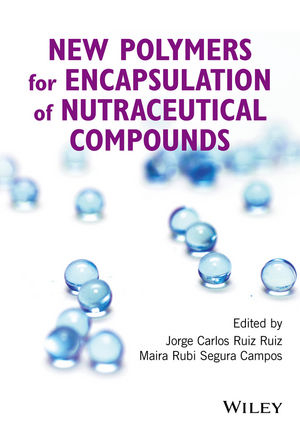
New Polymers for Encapsulation of Nutraceutical Compounds
John Wiley & Sons Inc (Verlag)
978-1-119-22879-0 (ISBN)
- Titel z.Zt. nicht lieferbar
- Versandkostenfrei
- Auch auf Rechnung
- Artikel merken
Jorge Carlos Ruiz Ruiz, Professor-researcher, Division de Estudios de Posgrado e Investigacion, Instituto Tenologico de Merida, Yucatan, Mexico. Maira Rubi Segura Campos,Professor-researcher. Facultad de Ingenieria Quimica, Universidad Autonoma de Yucatan.
List of contributors, xiii Preface, xix
Topic 1: Characterization of modified polymers and their use in encapsulation processes, 1
1 Tailor‐made novel polymers for hydrogel encapsulation processes, 3
Artur Bartkowiak, Katarzyna Sobecka, and Agnieszka Krudos
1.1 Introduction, 3
1.2 Well‐known and commonly used polymers, 16
1.3 Novel polymers, 16
Acknowledgments, 29
References, 29
2 High‐pressure‐treated corn starch as an alternative carrier of molecules of nutritional interest for food systems, 35
Lorena Deladino, Aline Schneider Teixeira, Antonio Diego Molina García, and Alba Sofia Navarro
2.1 Introduction, 35
2.2 Trends in nutraceutical foods, 36
2.3 Starch as a carrier for bioactive compounds, 40
2.4 Conclusions, 52
References, 53
3 Protein‐based nanoparticles as matrices for encapsulation of lipophilic nutraceuticals, 59
Adrián A. Perez, Osvaldo E. Sponton, and Liliana G. Santiago
3.1 General aspects of encapsulating lipophilic nutraceuticals, 59
3.2 Polyunsaturated fatty acid encapsulation systems, 60
3.3 Conclusions, 67
Acknowledgments, 68
References, 68
4 Surface modifications that benefit protein‐based nanoparticles as vehicles for oral delivery of phenolic phytochemicals, 73
Zheng Li
4.1 Overview, 73
4.2 Fabrication of protein‐based nanoparticles, 75
4.3 Obstacles to protein‐based nanoparticles as oral delivery vehicles, 79
4.4 Surface modifications of protein‐based nanoparticles for better delivery, 84
4.5 Summary, 92
References, 92
Topic 2: Stability of nutraceutical compounds encapsulated with modified polymers, 97
5 Novel polymer systems and additives to protect bioactive substances applied in spray‐drying, 99
Artur Bartkowiak, Wioletta Krawczyńska, and Alicja Federowicz
5.1 Introduction, 99
5.2 Spray‐drying process, 100
5.3 Nutraceuticals in the food industry, 107
5.4 Polymers and novel polymers used in the spray‐drying process, 109
Acknowledgements, 115
References, 115
6 The use of encapsulation to guarantee the stability of phenolic compounds, 121
Maria Inês Dias, Cristina Caleja, Isabel C. F. R. Ferreira, and Maria Filomena Barreiro
6.1 Introduction, 121
6.2 Phenolic compounds, 122
6.3 Microencapsulation process, 126
6.4 Concluding remarks and future perspectives, 135
References, 136
7 Fortification of dairy products by microcapsules of polyphenols extracted from pomegranate peels, 145
Wissam Zam
7.1 Extraction procedure, 145
7.2 Formulation of pomegranate peels’ polyphenol microbeads and their in vitro release, 146
7.3 Fortification of dairy products with polyphenol microcapsules, 153
References, 156
Topic 3: Application of encapsulated compounds with modified polymers in functional food systems, 159
8 Encapsulation technologies for resveratrol in functional food, 161
María Chávarri and María Carmen Villarán
8.1 Introduction, 161
8.2 Functional foods, 162
8.3 Resveratrol, 163
8.4 Encapsulation technology, 165
8.5 Microencapsulation, 168
8.6 Nanoencapsulation, 172
8.7 Conclusions, 182
References, 183
9 Nutraceutical compounds encapsulated by extrusion–spheronization, 195
Thi Trinh Lan Nguyen, Nicolas Anton, and Thierry F. Vandamme
9.1 Extrusion–spheronization process application for nutraceuticals, 195
9.2 Nanoemulsions for nutraceutical applications, 207
9.3 Nano‐size nutraceutical emulsion encapsulated by extrusion–spheronization, 211
9.4 Conclusion, 223
References, 223
10 Biopolymeric archetypes for the oral delivery of nutraceuticals, 231
Mershen Govender, Miles C. Braithwaite, Pradeep Kumar, Yahya E. Choonara, and Viness Pillay
10.1 Introduction, 231
10.2 Monolithic matrix‐based systems, 232
10.3 Encapsulated systems, 238
10.4 Conclusion, 247
Acknowledgments, 247
References, 247
11 Application of microencapsulated vitamins in functional food systems, 251
Siew Young Quek and Cheng Peng
11.1 Introduction, 251
11.2 Common microencapsulation techniques for vitamins, 254
11.3 Applications of incorporating encapsulated vitamins in dairy products, 255
11.4 Application of microencapsulated vitamins in beverages, 259
11.5 Application of encapsulated vitamins in bakery products, 263
11.6 Conclusions, 264
References, 265
12 Application of encapsulated compounds in functional food systems, 269
M. K. Tripathi and S. K. Giri
12.1 Introduction, 269
12.2 Microencapsulation technologies and bioactive food ingredients, 270
12.3 Delivery of bioactive ingredients into foods and to the gastrointestinal tract, 272
12.4 Techniques of microencapsulation, 275
12.5 Materials used for encapsulation, 279
12.6 Selection and safety evaluation of encapsulation materials, 279
12.7 Nutritional and nutraceutical compounds and microencapsulation, 280
12.8 Spray‐drying in microencapsulation of food ingredients, 287
12.9 Nanoencapsulation of food ingredients using lipid‐based delivery systems, 290
12.10 New techniques and ingredients that improve effectiveness of encapsulation, 292
References, 294
13 Encapsulation of polyunsaturated omega‐3 fatty acids for enriched functional foods, 301
Jorge Carlos Ruiz Ruiz and Maira Rubi Segura Campos
13.1 Introduction, 301
13.2 Functional effects of omega‐3 fatty acids, 303
13.3 Susceptibility to oxidation, 304
13.4 Methods for encapsulating oil, 304
13.5 Nonconventional wall materials for encapsulating oil, 305
13.6 Properties of oil as omega‐3 polyunsaturated fatty acids capsules, 309
13.7 Oxidation stability and fatty acid composition of encapsulated vegetable oils, 311
13.8 Incorporation of long‐chain omega‐3 polyunsaturated fatty acids in foods, 313
13.9 Conclusion, 314
Acknowledgments, 315
References, 315
Index, 321
| Erscheinungsdatum | 15.01.2017 |
|---|---|
| Verlagsort | New York |
| Sprache | englisch |
| Maße | 173 x 246 mm |
| Gewicht | 816 g |
| Themenwelt | Medizin / Pharmazie ► Medizinische Fachgebiete ► Pharmakologie / Pharmakotherapie |
| Naturwissenschaften ► Biologie ► Biochemie | |
| Technik ► Maschinenbau | |
| Weitere Fachgebiete ► Land- / Forstwirtschaft / Fischerei | |
| ISBN-10 | 1-119-22879-4 / 1119228794 |
| ISBN-13 | 978-1-119-22879-0 / 9781119228790 |
| Zustand | Neuware |
| Informationen gemäß Produktsicherheitsverordnung (GPSR) | |
| Haben Sie eine Frage zum Produkt? |
aus dem Bereich


